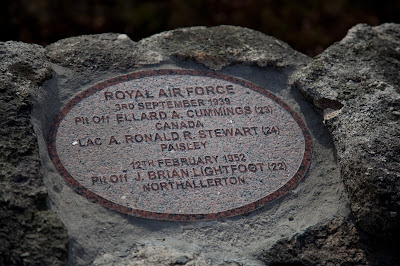August 1918 - by Duncan Harley
A young aviator
from Inverurie was killed in combat over Arnaville on August 30 1918 age just 20.
A lieutenant in the 55th Squadron of the newly formed RAF,
he lies buried in a small village churchyard near where he fell to earth and is remembered on a family gravestone over at the Bass of Inverurie.
An on-line tribute records that Thomas Laing, from Inverurie, Aberdeenshire, joined the fledgling Royal Air Force as a bomber pilot.
In the April of that year, he went off to train at the flying station in Narborough, Leicestershire, where he learnt how to fly his two-seat biplane day bomber. He wrote to his parents every 4 to 5 days, describing the thrill of flying at high altitudes and finally qualifying as a pilot. On 14 August 1918 Laing went on his first flight behind enemy lines, bombing ground targets in Germany. Just 16 days later he was shot down and killed.
After his death, his mother received a letter from a girlfriend. It ends “I keep on remembering little things he said and did. I just loved everything about him”. Along with the official notification his mother was to receive his flying goggles, identity bracelet and service medals along with an official RAF photograph as a memento of her dead son.
An on-line tribute records that Thomas Laing, from Inverurie, Aberdeenshire, joined the fledgling Royal Air Force as a bomber pilot.
In the April of that year, he went off to train at the flying station in Narborough, Leicestershire, where he learnt how to fly his two-seat biplane day bomber. He wrote to his parents every 4 to 5 days, describing the thrill of flying at high altitudes and finally qualifying as a pilot. On 14 August 1918 Laing went on his first flight behind enemy lines, bombing ground targets in Germany. Just 16 days later he was shot down and killed.
After his death, his mother received a letter from a girlfriend. It ends “I keep on remembering little things he said and did. I just loved everything about him”. Along with the official notification his mother was to receive his flying goggles, identity bracelet and service medals along with an official RAF photograph as a memento of her dead son.
Biggles
author, Captain W.E. Johns would have been familiar with such tragedy. Having
survived World War 1 combat with the Royal Flying Corps and spent time as a
prisoner of war after being shot down during a bombing raid over Mannheim,
Captain Johns was quick to take up the offer of a fishing holiday in the
North-east. London, in 1944, was under enemy attack. The Luftwaffe bombers had
given way to the unmanned flying bombs which struck daily terror into the
populace. And, commenting that “Enemy
action has at last forced me to leave my home”, the author gladly
travelled north to confront the salmon of the River Spey and the River Dee.
Alongside the fishing, the captain penned some dozen or so of his hundred Biggles books while staying in
the area and he may well have set his tale of kidnap, intrigue and adventure, ‘Biggles and the Poor Rich Boy’ in a local landscape which he would have been very
familiar with.Both Captain Johns and his fictional Biggles survived the years of aerial combat above the trenches, unlike the patriotic young lad from Inverurie.
T












Comments
Post a Comment